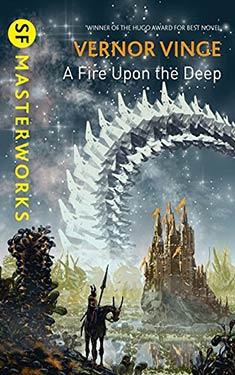1993 A Fire Upon The Deep
Vernor Vinge
Completed 9/10/2013, reviewed 9/16/2013
Rating: 3 stars
The back cover of the paperback edition of this book
contains a quote praising this as a great space opera. I’d heard the term. I knew “Star Wars” was considered a space
opera, but I wasn't exactly sure of the definition. I did some reading of sources on the net to
find one. To my surprise, the definition
is fluid. It has been changing,
evolving, going from a derogatory term to definition of a legitimate sub-genre. Reviewing the list of Hugo winner’s I've
read, and having done some preliminary scanning of reviews of those I haven’t,
it appears to me that the ‘90s were the decade of the space opera Hugos. "A Fire Upon The Deep" is one of these books.
The novel is complex, weaving multiple plots with multiple
narratives. There are two main
plots. The first is the survival of
children marooned on a planet whose sentient race is a dog-like creature. Called Tines, they have many of the
characteristics of Earth dogs, but their sense of personhood is only complete
when multiple individuals come together as a pack of four to eight dogs.
This plotline is great.
It’s imaginative and exciting. There
are many great characters: the two children Jeffri and Johanna, and the some of
the Tines, Peregrine, Woodcarver, Scriber.
These characters are threatened by the deliciously evil Flenser and
Steel, who are trying to overthrow the existing order with an army bred for
aggression and obedience.
In the second plotline, a rescue mission is launched on the
heels of the potential destruction of the galaxy by an evil man-made entity
called “The Blight.” It introduced the very interesting Skroderiders, a plant
like sentient being that communicates and is mobile because of a computer/vehicle
it rides on. And the main humans are
fairly interesting, Ravna and Pham.
These two humans and two Skroderiders take up the mission on the ship,
the Out Of Bounds II, to save the children.
I’d call this a penultimate space opera: marooned children, a civil war, the
destruction of the galaxy. There’s a
massive chase scene, a battle scene, a few narrow escape scenes, and, oh yeah,
the soapy relationship between Ravna and Pham.
The narrative jumps back and forth between the two plotlines. A good novel often has multiple plotlines and
voices. Here, though, I found it
weakened of the excitement of the children with the Tines, and often left me
with a feeling of incompleteness in the character development of the crew of
the OOB. Whenever the plot switched back
to the OOB, I felt annoyed that I was leaving the world of the Tines. But as the second plot would progress and the
characters develop, the narrative would switch back. Rather than organic and episodic, it usually felt
stuttered.
I didn't like how Vinge introduced new characters. Instead of bringing them in through the
existing voices, he introduced new ones. This introduced more disruption into the mix. Then
the characters leave the plot a chapter or two later. This style reminded me of Stephen King,
particularly in "Tommyknockers", where the main character’s sister is introduced
with great detail in one chapter, and killed off in the next. I didn't like it then, I didn't like it here.
Despite my frustration with the book’s format, I have to say
that in the end, I thought the book was good.
The last 100 pages were incredibly exciting. I think a good editor could have helped the
author keep the excitement at a better pitch. I give this book three stars.
I’d like to point out that this book tied for the 1993 Hugo
with Connie Willis’ Doomsday Book I
find this a travesty. I thought “Doomsday”
was far superior. That book gripped me
and I nearly cried at the end. “A Fire Upon
the Deep” had the potential with the marooned children plot, but over-reached
and ended up just another space opera.

No comments:
Post a Comment